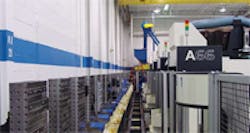A cell comprised of four horizontal 4-axis machines with a 28-pallet system and one vertical 5-axis machine with an 8-pallet system successfully ran 240 different parts at Bombardier Aerospace in Wichita, Kan.
However, the company believed it could do better, and changing parts faster from one setup to the next was the key.
Bombardier consulted Advanced Machine & Engineering (www.ame.com). That company demonstrated the advantages of incorporating sub-plates with hardened precision bushings and hardened threaded inserts on a 2-in. grid system to the existing pallet systems.
In addition, Advanced Machine & Engineering also showed that grid tombstones and plates, along with modular components, would allow Bombardier to locate and align extremely accurately and quickly on the 2-in. precision grid system.
The idea was a success.
The two cells now run 800 different parts, and monolithic parts run in single setups. Bombardier also experienced a 91-percent savings on set-up time and a total savings of 81 percent on cycle time over the old dedicated system.
At the start of the project, Drew Hanus, methods engineer at Bombardier, purchased several fullgrid tombstones with sub-plates, components and precision dowel screws, which were used for locating fixture plates onto tombstones or their pallets for quick changeovers.
While he was doing that, Advanced Machine & Engineering received Bombardier’s pallets and incorporated the bushings and threaded inserts along with locating and mounting holes. After integrating the 2-in. grid system into the pallets, the company inspected everything with a CMM, and calibration blocks were added to check the probe for repeatability of the machines.
At the beginning of each day, the blocks show where adjustments are needed to hold 0.0002-in. accuracy. A rotary axis check is also done on the fourth axis rotary table to ensure accuracy.
“The new system played a major role in allowing us to achieve our Six Sigma goals for this segment of our fabrication process. We now have improved set-up time, are producing better quality parts, and are saving money in the long run,” Hanus said.
